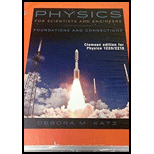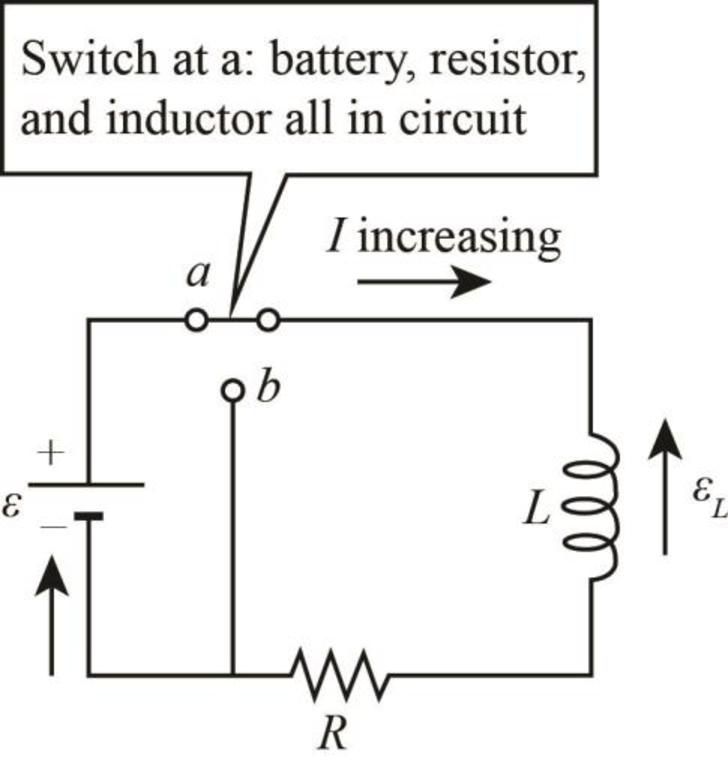
(a)
The expression for the total energy that dissipated by the resistor in one time constant.
(a)
Answer to Problem 17PQ
The expression for the total energy that dissipated by the resistor in one time constant is,
Explanation of Solution
The following figure shows the given diagram-

Figure-(1)
Here,
Write the expression for current pass through the resistor.
Here,
Write the expression for power dissipated in the resistor as function of time.
Here,
Substitute
Write the expression for energy dissipated
Substitute
Integrate the above expression between the limits
Conclusion:
Therefore, the expression for the total energy that dissipated by the resistor in one time constant is
(b)
The expression for the total charge that passes through the resistor in one time constant.
(b)
Answer to Problem 17PQ
The expression for the total charge that passes through the resistor in one time constant is,
Explanation of Solution
Write the expression for decaying current.
Write the expression for power dissipated in the resistor as function of time.
Substitute
Integrate the above expression between the limits
Conclusion:
Therefore, the expression for the total energy that dissipated by the resistor in one time constant is,
(c)
The comparison between the above two results and comment.
(c)
Answer to Problem 17PQ
The energy dissipated in the resistor when the current decays is more than the energy dissipated when the current grows in the circuit.
Explanation of Solution
Write the expression for energy growth that dissipated through the resistor.
Here,
Write the expression for energy decay that dissipated through the resistor.
Here,
Take the ratio of both equations.
Conclusion:
Substitute
Therefore, the energy dissipated in the resistor when the current decays is more than the energy dissipated when the current grows in the circuit.
Want to see more full solutions like this?
Chapter 33 Solutions
Physics for Scientists and Engineers: Foundations and Connections
- Hi! I need help with these calculations for part i and part k for a physics Diffraction Lab. We used a slit width 0.4 mm to measure our pattern.arrow_forwardExamine the data and % error values in Data Table 3 where the angular displacement of the simple pendulum decreased but the mass of the pendulum bob and the length of the pendulum remained constant. Describe whether or not your data shows that the period of the pendulum depends on the angular displacement of the pendulum bob, to within a reasonable percent error.arrow_forwardIn addition to the anyalysis of the graph, show mathematically that the slope of that line is 2π/√g . Using the slope of your line calculate the value of g and compare it to 9.8.arrow_forward
- An object is placed 24.1 cm to the left of a diverging lens (f = -6.51 cm). A concave mirror (f= 14.8 cm) is placed 30.2 cm to the right of the lens to form an image of the first image formed by the lens. Find the final image distance, measured relative to the mirror. (b) Is the final image real or virtual? (c) Is the final image upright or inverted with respect to the original object?arrow_forwardConcept Simulation 26.4 provides the option of exploring the ray diagram that applies to this problem. The distance between an object and its image formed by a diverging lens is 5.90 cm. The focal length of the lens is -2.60 cm. Find (a) the image distance and (b) the object distance.arrow_forwardPls help ASAParrow_forward
 Physics for Scientists and Engineers: Foundations...PhysicsISBN:9781133939146Author:Katz, Debora M.Publisher:Cengage Learning
Physics for Scientists and Engineers: Foundations...PhysicsISBN:9781133939146Author:Katz, Debora M.Publisher:Cengage Learning Physics for Scientists and EngineersPhysicsISBN:9781337553278Author:Raymond A. Serway, John W. JewettPublisher:Cengage Learning
Physics for Scientists and EngineersPhysicsISBN:9781337553278Author:Raymond A. Serway, John W. JewettPublisher:Cengage Learning Physics for Scientists and Engineers with Modern ...PhysicsISBN:9781337553292Author:Raymond A. Serway, John W. JewettPublisher:Cengage Learning
Physics for Scientists and Engineers with Modern ...PhysicsISBN:9781337553292Author:Raymond A. Serway, John W. JewettPublisher:Cengage Learning Principles of Physics: A Calculus-Based TextPhysicsISBN:9781133104261Author:Raymond A. Serway, John W. JewettPublisher:Cengage Learning
Principles of Physics: A Calculus-Based TextPhysicsISBN:9781133104261Author:Raymond A. Serway, John W. JewettPublisher:Cengage Learning
 Physics for Scientists and Engineers, Technology ...PhysicsISBN:9781305116399Author:Raymond A. Serway, John W. JewettPublisher:Cengage Learning
Physics for Scientists and Engineers, Technology ...PhysicsISBN:9781305116399Author:Raymond A. Serway, John W. JewettPublisher:Cengage Learning





